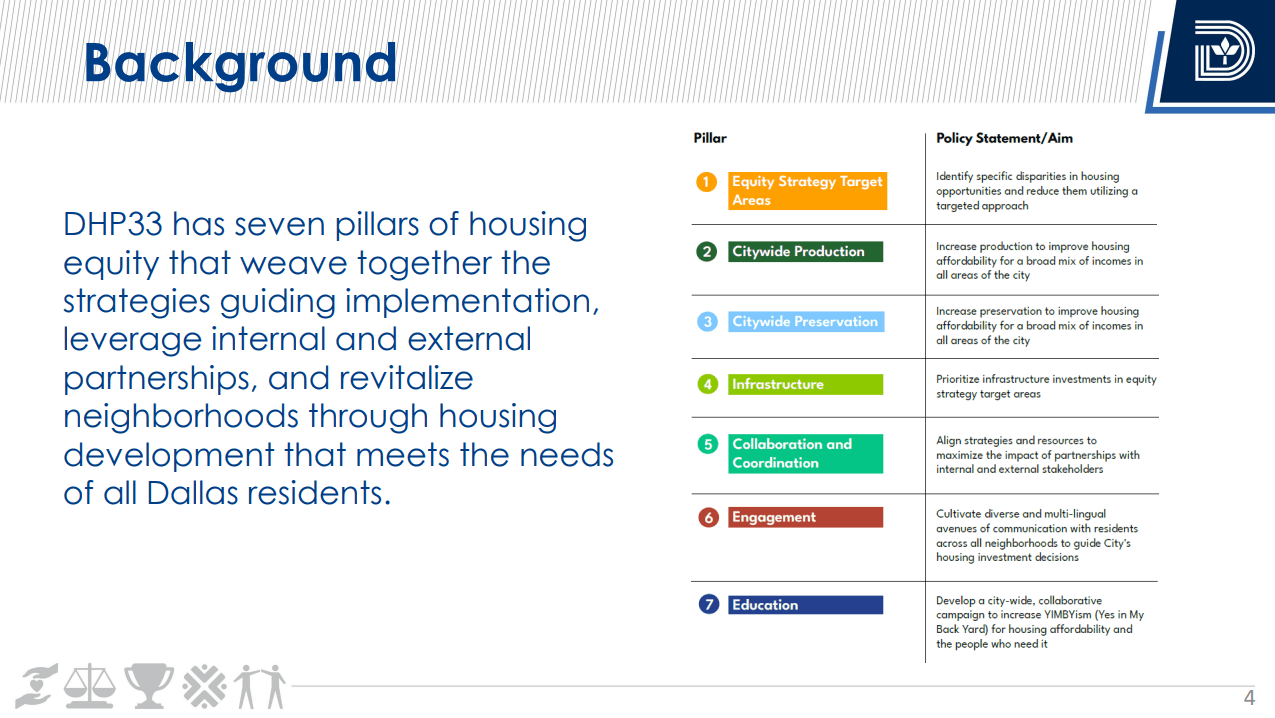The City of Dallas is targeting specific neighborhoods to implement “housing equity.”
City staff have identified three “Equity Strategy Target Areas” where they recommend the City focus its “affordable housing” projects, as discussed in a Monday briefing of the Dallas City Council Workforce, Education, and Equity Committee.
Department of Housing & Neighborhood Revitalization area redevelopment manager Jasmine Bazley explained that the Dallas Housing Policy 2033, adopted by the Dallas City Council last year, is built on seven pillars of “housing equity.”
The first pillar is “Equity Strategy Target Areas,” meaning that the City should “identify specific disparities in housing opportunities and reduce them utilizing a targeted approach.”
City staff have selected three areas in Dallas to be considered for these “Target Areas,” largely in central and southern Dallas.
The process of selecting the areas included considerations of “racial equity,” poverty, homeownership rates, “social and economic vulnerabilities,” and community engagement, according to the staff’s presentation.
The three areas largely fall in Districts 4 and 7, represented by Council Members Carolyn King Arnold and Adam Bazaldua, respectively.
Both council members expressed support for the Target Area efforts, but Bazaldua said he was concerned the City would not actually implement the initiative.
“I really appreciate the work put into this,” he said. “I just hope that we look at what’s before us as more than just a plan … that just sits on the shelf.”
“I’m becoming … somewhat jaded when I see things that get me excited based on logic and data from our City, but then I see action taken by our City that completely discredits and contradicts the direction we’re supposed to be going in,” Bazaldua continued. “When I look at something like this, it does get me excited … but at this point, I’m not super optimistic on our implementation.”
“I was equally excited when I saw [the] Racial Equity Plan being passed, but then … we’re about to pass a bond that doesn’t reflect it,” he said.
Interim director Cynthia Rogers-Ellickson responded to Bazaldua’s concerns and said the housing department has committed to using 50% of its taxpayer funding for these Target Areas, including the department’s allocations from the upcoming bond program.
Arnold championed the Target Areas and said Dallas must remain committed to “racial equity” through its housing efforts and bond program.
“All in all, what we need to keep in front of everyone around the horseshoe who made a commitment to racial equity is that we must follow through with this particular plan,” said Arnold. “We know that equity is not comfortable, but being disconnected and overlooked for generations is not comfortable either.”
“These communities can no longer wait. … When you connect [Districts] 4 and 7, you’re pretty much going to revolutionize the cityscape,” she added.
Council Member Jaynie Schultz (District 11), chair of the committee, said other council members should also support the Target Areas.
“For those of us who do not have Target Areas, we need to put all of our efforts [in] making sure … these Target Areas are successful and that we add more,” she said.
However, Council Member Paul Ridley (District 14) said officials should not lose focus on supporting housing for the whole of Dallas.
“While I subscribe to the concept of targeting underprivileged areas for housing and equity improvements and programs, I can’t help but notice the built-in tension between pillar one and pillars two and three,” he said.
While the first pillar of the Dallas Housing Policy 2033 focuses on Target Areas, the next two aim to increase the production and preservation of “affordable housing” city-wide.

“Although you have mentioned a couple of times in the report that city-wide housing programs will continue, I hope that’s more than just lip service,” he said. “We have some wonderful housing programs, and I just want to make sure that they don’t get lost in the shuffle from the focus on these three target areas.”
Ridley said every council district has “pockets of poverty” with “substandard homes” that “need to be addressed as well.”
The next steps for the Target Areas will involve staff engaging more with the communities of the areas and working to establish a Housing Task Force to serve as an advisory body.


